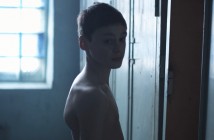LA EigaFest (LAEF) is a weekend-long Japanese film festival held in Los Angeles and hosted by the Japan Film Society, inaugurated in 2011. Now in its second year, LAEF made several logistical changes very much to its advantage, especially in a city rife with film festivals all year long. Firstly, LAEF moved its schedule to December so as not to serve as the ‘chaser’ for the monster event that is the AFI Film Festival. Secondly, LAEF moved its screening quarters from the Chinese Mann theatres to the Egyptian theatre, with the American Cinematheque thus serving as this year’s co-presenter. Thirdly, LAEF provided a ramen booth throughout the festival following opening night, just to remind us that cinema and ramen go together marvelously well. (In fact, to further stress this great combination, among the screenings at LAEF 2012 was the animated series “Top Chefs: The Wide-World of Japanese Food Anime.”)
With programming by Bryan Hartzheim, LAEF 2012 continued its mixture of blockbuster and independent filmmaking, neatly divided between feature films and short films. Significantly, 2012 has been a strong year for Japanese films at the domestic box office, especially compared to 2011. Thus far the top five highest-grossing films are all Japanese titles; in contrast, 2011 saw only one Japanese title crack the top five highest-grossing films amidst Hollywood productions
. If folks inside and outside of Japan bemoan the diminution of presence of Japanese cinema in the landscape of world cinemas and film festivals, especially in relation to the vibrant cinemas of China and South Korea, sadly such diminution is a matter of distribution. Of course, for other folks Japanese cinema and the film industry in general are precisely the problem for such diminution of presence. As producer Saka Misako states in a recent interview, “The entire Japanese film business itself is not changing or developing in any way.” The same goes for Japanese culture in general and its place within global flows and markets. The recent article “Is Japan Losing Its Cool?” seeks specifically to unpack how Japan’s cultural cachet is losing its cool and what the government and media industries can do to support and translate the prolific creativity of Japanese artists into exportability at a global level, especially in relation to South Korea’s ongoing blossoming not only across Asia but the world over.
Though still in its infancy, LAEF can certainly help to alleviate the dearth of theatrical distribution of Japanese films in the U.S., given that the west coast does not have an equivalent to New York’s annual two-week long Japan Cuts series on the one hand and the Japanese Film Festival Los Angeles (JFFLA) leaves a lot to be desired in terms of marketing and programming on the other.
While LAEF 2011 consisted of feature film and short film competition awards, LAEF 2012 concentrated solely on the short films through the Golden Zipangu Awards. Further supporting emerging Japanese independent filmmakers to contrast with blockbuster live-action and animated features were selections from the Short Shorts Film Festival. One of the featured shorts was Kishimoto Tsukasa’s Mother of the Groom/ニービチの条件 (2011), a pleasant story of a young Okinawan man who returns to his hometown from the mainland with his fiancée to obtain his parents’ blessing for his upcoming marriage. Nicely paced sitcom family-like comedy ensues, born from the stubbornness of everyone involved about the severing of family ties and the usefulness (or uselessness, depending on whose point of view) of renewing such ties.
Among the seven live-action feature films showcased at LAEF 2012, The Kirishima Thing/桐島、部活やめるってよ (2012, Yoshida Daihachi) deserves special mention. It presents a surprisingly different, thoughtful, and nuanced approach to the Japanese high school film, based on Asai Ryo’s novel, such that its examination of human interaction specifically emphasises that its young characters are discovering and beginning to forge individual identities above and beyond those of the clique, to whichever clique one may belong. That the film takes place over the course of several days, entirely at a high school, concentrates such emphasis on the emotional and psychological transitions (to put it mildly) that adolescents experience.
Yoshida, who wrote the screenplay, focuses on the social hives of jocks, the popular girls, band members, and cinephiles and draws out their complex, sprawling socio-emotional connectivity/hierarchy in a high school through the titular Kirishima. Kirishima is also a student at the high school, but he is never seen. Kirishima’s unexpected absences from the school and its equally unexpected impact on his friends’ lives and sense of self are in fact the film’s deceptively simple premise.
To establish the socio-emotional connectivity/hierarchy that operates in a high school, Yoshida presents the first day’s events at the school through multiple perspectives: the popular crowd of Hiroki (Higashide Masahiro), Kirishima’s best friend; Risa (Yamamoto Mizuki), Kirishima’s girlfriend; Risa’s closest friend Sana (Matsuoka Mayu), Hiroki’s girlfriend; and Risa’s other friends Kasumi (Hashimoto Ai) and Mika (Shimizu Kurumi), who bridge the gap between the popular crowd and the non-popular crowd headed by budding filmmaker and film club head Ryoya (Kamiki Ryunosuke), who has a crush on Kasumi; his close colleague Takefumi (Maeno Tomoya); and Aya (Ohgo Suzuka), deeply in love with Hiroki. Each succeeding perspective goes further back in time to provide a wider view of this particular social world and its dynamics. The perspectives are so surprisingly numerous that one begins to think that the entire film will consist of this one day’s events refracted by a host of perspectives, all the better to convey the sense of uncertainty, serendipity, and anxiety of self, friendship, desire, and communication that permeate in high school. But the film moves on to snapshot events of succeeding days, while the accumulating emotional and psychological impact of Kirishima’s disappearance and unknown coordinates conveys all of the above with unassuming humour and sensitivity, complicit with a fantastic young cast.
Though the events are not bathed in and determined by violence, the film is not without its conflicts, the primary one between Kirishima and the students; it plunges those who know and do not know him into isolation and disconnect from others. At the same time, what helps to bridge the elite students and the non-elite is film itself: Kasumi and Ryoya bump into each other at a screening of Tetsuo: The Iron Man (1989, Tsukamoto Shinya), while the climax involves a confrontation between the two groups during the shooting of Ryoya and company’s high school zombie film.
83/100
For her sophomore effort Helter Skelter (2012), Ninagawa Mika adapted Okazaki Kyoko’s 2003 manga. Those who have seen Masumura Yasuzo’s biting comedy Giants and Toys (1958) and its representation of the Japanese media industry’s quick manufacture and disposal of idols, or stars, will find in Helter Skelter another depiction of this especially cut-throat, unrepentant world through the beauty icon Ririko (Sawajiri Erika) and her physical-mental fall from the limelight. For Ririko, ‘manufacture’ has a literal meaning: her entire face and body are the result of the most advanced technological developments in plastic surgery, a financial gamble that her manager Hiroko (Momoi Kaori) took to create a money-making machine. But Ririko is far from a victim and does not play one; she possesses a drive that is perhaps propelled by her very distortion.
The film begins at the height of Ririko’s popularity, gracing every magazine cover, appearing in every other commercial, and making guest appearances attended by rabid fans. Put another way, the film begins at the point when her surgically enhanced body shows signs of its constructedness in the form of bruise-like marks, as if her actual body were crumbling underneath the weight of all of the changes it has suffered. The same then goes for her mental state. Photo and commercial shoots, interviews, and television and other public appearances become increasingly a process of forced, grotesque self-reflection/loathing, to which she gives vent in her elaborately decorated apartment as if she were the portrait of Dorian Gray—her devoted personal assistant Michiko (Terajima Shinobu) receiving the brunt of her multifarious moods. Matters further deteriorate when younger rival model Kozue (Mizuhara Kiko) enters her world and bursts the bubble of adoration in which she has been living. Paired with an investigation of a string of deaths among women who have undergone similar grueling cosmetic surgeries, led by meditative prosecutor Asada (Omori Nao), Helter Skelter is a truly naked, macabre portrait of beauty and idol industries.
Helter Skelter’s excess and cruel satire is morbidly engaging thanks to the four women behind and in front of the camera. Apart from being one of the few women filmmakers in Japan, Ninagawa is one of the country’s most famous photographers. As with her feature debut Sakuran (2006), she brings to this tale her maddeningly colourful eye to visual composition and set design; such hyper colours aptly contrast with and complement Ririko’s unraveling being. And who could be a more suitable, fearless Ririko as a comeback role than model/actress/singer Sawajiri? Sawajiri has courted controversy for her blunt views and attitude about Japanese talent management/agencies and in guest appearances, precisely because she has experienced the pitfalls of being a talent under contract. In this sense, she and Sakuran actress Anna Tsuchiya share the quality of being strong, outspoken women. Tempering Sawajiri’s youth are Momoi and Terajima, terrific in their roles as rapacious and pathetically doting, respectively. Ninagawa is thus developing a very interesting body of work on beauty cultures, women’s bodies, and social norms.
76/100
 The box-office hit Thermæ Romæ (2012, Takeuchi Hideki) is based on Yamazaki Mari’s 2007 manga of the same title. Admittedly, it is an intriguing slapstick of a work in national/ist and cross-cultural terms, beyond its broad comedy through its time-travel premise and titillation through lead actor Abe Hiroshi being shirtless or downright nude about thirty percent of the film’s running time. Abe plays ancient Roman bathhouse architect Lucius Modestus, who continually stumbles upon a portal that transports him from Roman bathhouses to present-day Japanese bathhouses. To be sure, Abe as Lucius in ancient Rome speaks Japanese, as do Emperor Hadrian, Antoninus, Ceionius, and everyone else, either because they are dubbed or portrayed by Japanese actors (as in the case of the three above-mentioned characters). Yet when Lucius finds himself in Japan, he speaks Latin. The narrative crux is that ancient Rome’s bathhouse culture, which Lucius finds stagnating and in need of innovation, finds in contemporary Japanese bathhouses and hot springs not only the innovation but also the convenience and emotional/physical healing qualities to help Rome’s populations, Hadrian’s personal trauma, Roman soldiers in battle, and assure that history remains intact.
The box-office hit Thermæ Romæ (2012, Takeuchi Hideki) is based on Yamazaki Mari’s 2007 manga of the same title. Admittedly, it is an intriguing slapstick of a work in national/ist and cross-cultural terms, beyond its broad comedy through its time-travel premise and titillation through lead actor Abe Hiroshi being shirtless or downright nude about thirty percent of the film’s running time. Abe plays ancient Roman bathhouse architect Lucius Modestus, who continually stumbles upon a portal that transports him from Roman bathhouses to present-day Japanese bathhouses. To be sure, Abe as Lucius in ancient Rome speaks Japanese, as do Emperor Hadrian, Antoninus, Ceionius, and everyone else, either because they are dubbed or portrayed by Japanese actors (as in the case of the three above-mentioned characters). Yet when Lucius finds himself in Japan, he speaks Latin. The narrative crux is that ancient Rome’s bathhouse culture, which Lucius finds stagnating and in need of innovation, finds in contemporary Japanese bathhouses and hot springs not only the innovation but also the convenience and emotional/physical healing qualities to help Rome’s populations, Hadrian’s personal trauma, Roman soldiers in battle, and assure that history remains intact.
This narrative allows Japan to regard itself on a par with the Roman Empire, with tongue firmly in cheek, sure enough. At the same time, given Japan’s self-proclaimed uniqueness from Asia on the one hand and admiration of Europe on the other, one cannot help thinking that a level of seriousness is also at work to fulfill national self-conceptions. The narrative also teases out somewhat the Japanese conception of the white western foreigner. While the word gaijin literally means “outside person,” it specifically designates white European/American. Abe as the principal gaijin is interesting in that it humourously reflects and comments on the Japanese fascination with him, especially his physique and features. Abe can play virtually any character, and has been steadfastly doing so on film and television since transitioning from modeling to acting in the late 1980s. A second-century Roman architect is no exception; Abe revels in the mayhem of time-travel and its clause of multilingualism, his character’s intense preoccupation with making bathhouse culture ever more functional and therapeutic, and showcasing his torso for what seems like every ten minutes.
If the idea of time travel between second-century Rome and twenty-first-century Japan seems too absurd a journey, well, that is partly the point and where most of the fun and laughs come from. The sections that drag are unfortunately whatever that is peripheral to Lucius and his comings-goings through liquid time portals; these sections are his marital woes and the political intrigue involving Hadrian, Ceionius, and Antoninus with regards to imperial succession in Rome, and a young aspiring manga artist and her wacky bathhouse-owning family in Japan. This family and their friends (including one played by Takeuchi Riki, who still sports a mullet but looks rather bloated) eventually find themselves in Rome at some point to help Lucius with his ancient Roman architectural and socio-political problems.
63/100



